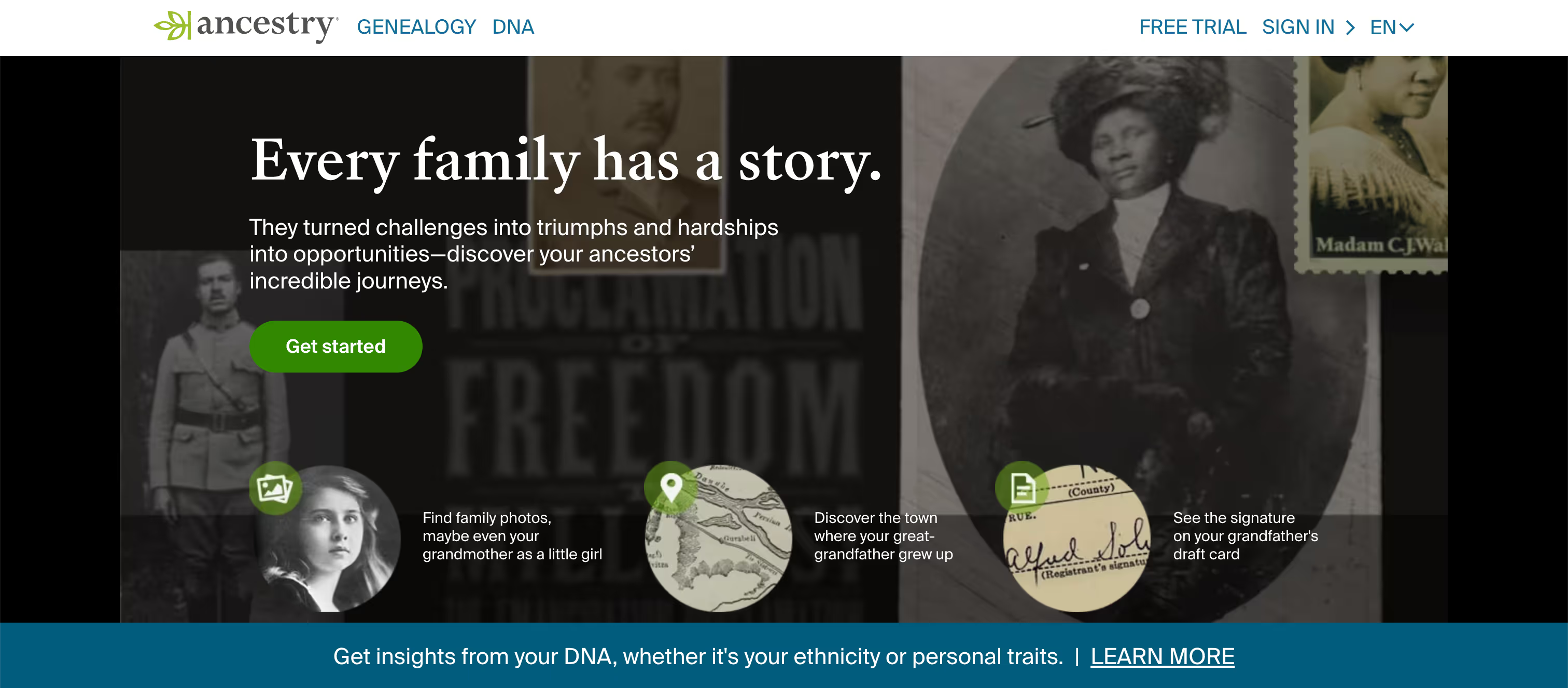Guaranteed to teach you things you never knew.
7 Best Tools to Record and Capture Family Memories & Stories
7 of the best tools to help families capture, record, and celebrate their memories and stories. From voice recording to photo books, these tools can help families preserve their history and create lasting memories.
Family stories are an essential part of our family history, heritage, and culture. They provide a window into our past and a way for future generations to connect with those who have gone before them. Unfortunately, these stories can easily be forgotten or lost over time. Luckily, there are plenty of apps and tools available to help us capture and preserve our family stories for future generations. From photo journals to family tree apps, read on to discover the seven best tools for recording your family history and capturing family memories.
1. Remento - Best all-around way to record family stories
.png)
Remento transforms storytelling into something deeply personal and truly effortless. Instead of typing, storytellers simply speak naturally in response to weekly prompts delivered by text or email. Using Speech-to-Story technology, Remento automatically transforms those voice or video recordings into beautifully written stories that read as though a professional writer crafted them.
But the experience goes far beyond transcription. Remento gives families the power to choose how each memory is told, whether as a lightly edited transcript that keeps the storyteller’s rhythm, or as a polished first-person narrative that reads like a memoir. Once stories are ready, they’re compiled into a hardcover book that pairs written chapters with QR codes linking to the storyteller’s original recordings. Readers can hear every laugh, pause, and tone — blending the permanence of print with the intimacy of voice.
It’s as much an experience as a product. Remento’s collaborative platform allows family members to choose or vote on prompts, upload photos, and share reactions as new stories are recorded. The process often becomes a weekly family ritual, sparking conversations, uncovering forgotten moments, and bringing generations together.
Unlike other services that require writing or technical setup, Remento was designed specifically for ease and accessibility. Storytellers don’t need to log in or download anything; they simply click a secure link and start talking. Everything from recording to editing to printing, is handled automatically, ensuring that families can focus on what really matters: connection.
Pros:
- Preserves both story and voice: Unlike traditional memoir tools, Remento captures a storyteller’s authentic voice alongside their written narrative through QR-linked recordings, making the experience emotional and deeply personal.
- No editing required: Remento’s Speech-to-Story™ technology turns recordings into either “cleaned transcripts” or more narrative-style (fully editable) stories, designed to feel like a professional writer had been hired to document the memories while retaining the storyteller’s tone and personality.
- Effortless for older adults: No writing, typing, or logins required. Storytellers simply speak their memories, making it accessible even for those who find technology intimidating.
- Creates a multi-sensory keepsake: The 8” x 10” hardcover book blends text, audio, and photos into a vivid family heirloom that can be read, heard, and shared.
- Encourages meaningful family connection: Weekly prompts and collaborative tools invite children and grandchildren to participate, turning memory capture into an ongoing family ritual.
- Discover the stories behind photos: Use photos to spark memories by adding them to prompts, or adding them after a recording to bring the story to life.
Cons:
- Not ideal for writers: Remento was designed for people who prefer the ease of speaking their stories over the chore of writing them.
- Voice recording comfort required: Storytellers must be comfortable speaking aloud and recording themselves (although they can do so from any device and without any downloads, logins, or passwords)
- Newer company: As seen on Shark Tank, Remento was founded in 2021 compared to other companies that have been printing text-based books for over a decade.
Best for: Families who want to capture both the story and the storyteller’s voice.
Learn more: Remento Reviews
2. Storyworth® - Best for capturing written family stories

Storyworth has become one of the most popular tools for capturing family memories. Each week, it sends a question—such as “What was your first job?” or “What do you remember most about your parents?”—to your chosen storyteller. Over the course of a year, those written or dictated responses are compiled into a hardcover book. Storyworth offers structure and simplicity, making it a great fit for families who enjoy reflective writing. However, it’s primarily a text-based experience: dictated responses are transcribed exactly as spoken, and audio recordings aren’t saved, so the storyteller’s voice itself isn’t preserved.
Pros:
- Preferred by writers: Ideal for those who enjoy reflective writing or prefer full control over their words.
- Structured and reliable: Weekly prompts over 52 weeks provide a consistent storytelling cadence.
- Produces a polished book: Creates a hardcover, keepsake book with clean design and consistent formatting.
Cons:
- No voice preservation: Recordings of the storyteller are not accessible through the book.
- Verbatim transcription only: Dictated stories appear exactly as spoken, often without punctuation or cleanup, making them feel raw or fragmented - not ideal for less-structured speakers.
- Can’t record the stories behind photos: Photos can be added to existing stories, but they cannot be used to inspire the sharing of memories associated with the image itself.
- Smaller (and more expensive) books: Printing additional copies of Storyworth’s 6”x9” color-printed books costs $79 each.
- Limited collaboration: Family members can suggest prompts and edit stories, though the platform doesn’t include interactive features like commenting or shared feedback within the story itself.
Best for: Aspiring autobiographers.
Learn more: Storyworth Reviews
3. Ancestry.com - Best for adding stories to genealogical records

Ancestry.com is a genealogy platform used by millions of people to research their family history and discover new relatives. It offers users access to billions of historical records and family trees, as well as powerful search and analysis tools.
Pros:
- Offers access to historical records and documents.
- Allows customers to build a family tree.
- Offers DNA testing to help customers connect with distant relatives.
Cons:
- Subscription plans can be expensive for those who are only interested in a few features.
- Limited access to DNA testing for people outside the US, UK, Canada, Ireland, Germany, and Australia.
- No easy way to capture family stories.
4. Storied - Best for adding stories to archival documents

Storied is a new family history site that lets users build a family tree, search historical records and newspapers, craft stories, relive memories, collect photos, and pull it all together by collaborating with groups of family and friends.
Pros:
- Allows multiple users to work together on stories.
- Promotes collaboration and creative expression.
- Access to a robust collection of historical records and newspapers.
Cons:
- Requires export of content from other family tree services, like Ancestry.com.
5. LegacyBox - Best tool for digitizing family photos and videos

LegacyBox is a popular platform that allows users to digitize their old photos, videos, and film reels, preserving memories in digital form. With LegacyBox, users can quickly and easily transfer, organize, and store their memories. The platform also offers different print sizes and items available for purchase, such as photo books and calendars.
Pros:
- Easy and convenient way to digitize and preserve home movies and photos.
- Simple and straightforward process.
- Excellent customer service and a customer satisfaction guarantee.
Cons:
- More expensive option for digitizing and preserving home movies and photos.
- Requires putting precious family artifacts in the mail.
- Digitized content arrives disorganized and in a format that’s difficult to share.
6. Shutterfly - Best tool for creating printed photo books

Shutterfly is an online photo and video sharing platform, allowing users to store and share their memories through photos, videos, and other digital media. It also offers a range of services to help users turn their photos into prints, cards, and other customizable items.
Pros:
- Offers a range of customization options, enabling users to create their own photo albums and memory books.
- A wide selection of designs and templates to choose from.
Cons:
- The service can be expensive.
- Manually sorting through large volumes of photos can feel cumbersome.
- No easy way to share the final product digitally.
7. Aura - Best digital picture frame

Aura Frame is a digital photo frame that allows users to easily share their photos with friends and family. It has an app that can be downloaded to any device, allowing users to upload their photos, videos, and other digital content to the frame. With Aura Frame, users can also create custom photo albums and slideshows of their favorite memories.
Pros:
- App allows for easy sharing of photos directly to a frame.
- A great way for non-tech-savvy older relatives to enjoy digital photos.
- Great customer support.
Cons:
- The hardware is expensive.
- The app does not sync with other photo-sharing platforms.
- Does not support video streaming.
Choosing the Right Tool for Your Family
Each of these platforms offers a different lens on storytelling:
- Storyworth and My Life in a Book are best for written memoirs.
- Artifact and StoryCorps excel at audio storytelling.
- FamilySearch and FamilyAlbum focus on organization and archival.
- Remento combines the best of all worlds — preserving both the written story and the living voice behind it.
If your goal is not only to remember what your loved one said, but how they said it — Remento is the bridge between past and present that every family deserves.
Final Thoughts
Every family has stories worth saving — small moments, big memories, and the voices that hold them all together. Whether you choose a writing-based tool like Storyworth or an immersive, voice-preserving platform like Remento, the most important thing is to start recording today.
Because once you capture those stories — in words, in sound, or both — they become part of your family’s legacy forever.

Their stories, forever at your fingertips
Remento’s life story books turn a parent or grandparent’s memories of the past into a keepsake book for the future - no writing required.
Capture priceless family memories today
Join the thousands of families using Remento to preserve family history, all without writing a word.
.avif)
